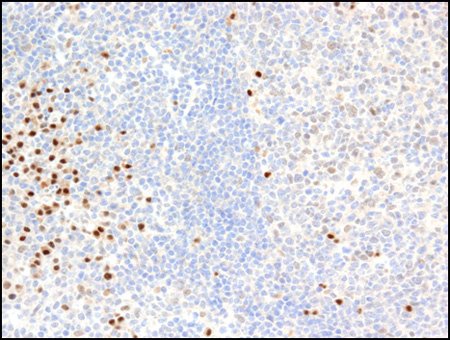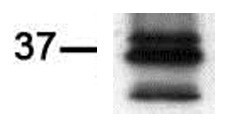PIM2 antibody (mAb) (Clone CHU61)
Host / Isotype
Rat / IgG2a
Reactivity
Human
Applications
IHC, WB
CloneNo.
CHU61
Cat No : 61159,61160 61159
Synonyms
Validation Data Gallery
Product Information
| Tested Applications |
IHC, WB
Applications Validated by Active Motif: IHC: 2 ug/ml dilution WB: 0.5 - 2 ug/ml dilution The antibody is suitable for IHC on paraffin sections. Frozen sections are not recommended. This antibody is also available as an AbFlex engineered recombinant antibody. For details on the corresponding AbFlex Recombinant Antibody, see Catalog No. 91239. |
| Tested Reactivity | Human |
| Host / Isotype | Rat / IgG2a |
| Class | Monoclonal |
| Type | Antibody |
| Immunogen | This PIM2 antibody was raised against a recombinant protein corresponding to human PIM2. |
| Full Name | PIM2 antibody (mAb) (Clone CHU61) |
| Synonyms | PIM2, serine threonine protein kinase, CAMK, pim-2, pim2h, pim-2h, pim 2, I-kB kinase, NF-kB, BAD, lymphocytes, leukemia, lymphoma, adenocarcinomas, hepatocellular carcinomas, monoclonal, clone CHU61, sample |
| Molecular weight | 37 kDa |
| GenBank accession number | NP_006866 |
| RRID | AB_2615012 |
| Purification Method | Protein G Chromatography |
| Buffer | Purified rat IgG in PBS with 30% glycerol and 0.035% sodium azide. Sodium azide is highly toxic. |
| Storage | Some products may be shipped at room temperature. This will not affect their stability or performance. Avoid repeated freeze/thaw cycles by aliquoting items into single-use fractions for storage at -20°C for up to 2 years. Keep all reagents on ice when not in storage. |
Background Information
PIM2 is a serine/threonine protein kinase in the CAMK family. PIM2 promotes cell survival in response to a variety of proliferative signals through activation of the I-kB kinase/NF-kB pathway. It also inhibits apoptosis through the phosphorylation of BAD. PIM2 has been implicated in the transformation of both T and B lymphocytes and is highly expressed in human leukemia and lymphomas, as well as adenocarcinomas and hepatocellular carcinomas.


